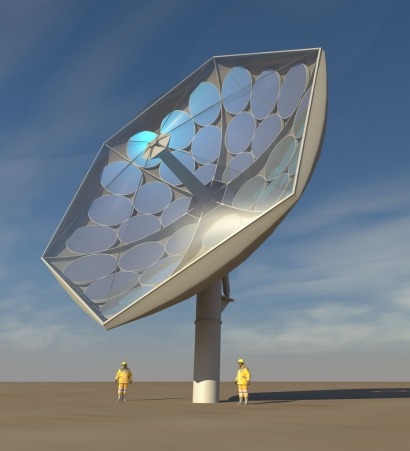
Scientists have announced a collaboration to develop an affordable PV system which could harness the power of 2,000 suns and collect 80 percent of incoming radiation converting it to useful energy. The system could be built in any location where sustainable energy, drinking water and cool air are in short supply and at a cost three times lower than comparable systems.
The design for the system is based on a low-cost, dish-like concentrator and micro-channel cooled high performance PV chips which could be mass produced. Scientists at IBM Research, Airlight Energy, ETH Zurich and Interstate University of Applied Sciences Buchs NTB have been awarded a three-year $2.4 million grant by the Swiss Commission for Technology and Innovation in order to research and develop the project which is based on a study by the European Solar Thermal Electricity Association and Greenpeace International. The study concludes that it would take only two percent of the Sahara Desert’s land area to supply the entire world’s electricity needs, however current systems on the market today are too expensive and slow to produce and they also require rare Earth minerals while also lacking the efficiency required to make such massive systems practical.
The prototype High Concentration Photovoltaic Thermal (HPVT) system uses a large parabolic dish made from multiple mirror facets and attached to a tracking system. The sun’s rays will reflect off the mirror on to several micro-channel liquid-cooled receivers with triple junction PV chips with each 1cm x 1cm chip being able to convert 200-250 watts of solar energy over a typical eight hour day in a sunny region.
“We plan to use triple-junction photovoltaic cells on a microchannel cooled module which can directly convert more than 30 percent of collected solar radiation into electrical energy and allow for the efficient recovery of waste heat above 50 percent,” said Bruno Michel, manager, advanced thermal packaging at IBM Research. “We believe that we can achieve this with a very practical design that is made of innovative concrete trackers, primary optics composed of inexpensive pneumatic mirrors and structures made of concrete -- it’s frugal innovation, but builds on decades of experience in lightweight and high strength concrete elements used for building bridges.”
The solar concentrating optics will be developed by ETH Zurich and the scientists believe they can achieve a cost per aperture area below $250 per square meter, three times lower than comparable systems. The Levelized Cost Of Energy (LCOE) will be less than 10 cents per kilowatt hour (KWh) compared to current Feed-in Tariffs for electrical energy in Germany of more than 25 cents per KWh.
In order to provide fresh water scientists are utilizing a technology they developed for water-cooled supercomputers. In the HCPVT system the 90 degree C water will pass through a porous membrane distillation system where it is then vapourized and desalinated. This could provide 30-40 litres of drinkable water per square meter of receiver area per day while still generating electricity with a more than 25 percent yield. This is a little less than half the amount of water the average person needs per day according to the United Nations. A large installation could provide enough water for a small town. The HCPVT could also provide air conditioning by means of a thermal driven adsorption chiller, a device that converts heat into cooling via a thermally cycle applied to an absorber made from silica gel.
The scientists believe the HCPVT system could provide sustainable energy and fresh water to areas such as Southern Europe, Africa, the Arabian peninsula, the south west region of North America, South America and Australia. Remote tourist locations such as the Maldives, Seychelles and Mauritius could be catered for as well.
The prototype HCPVT is currently being tested at IBM Research in Zurich, Switzerland. Several other prototypes will be built in Biasca and Rüschlikon, Switzerland.
Further information:

